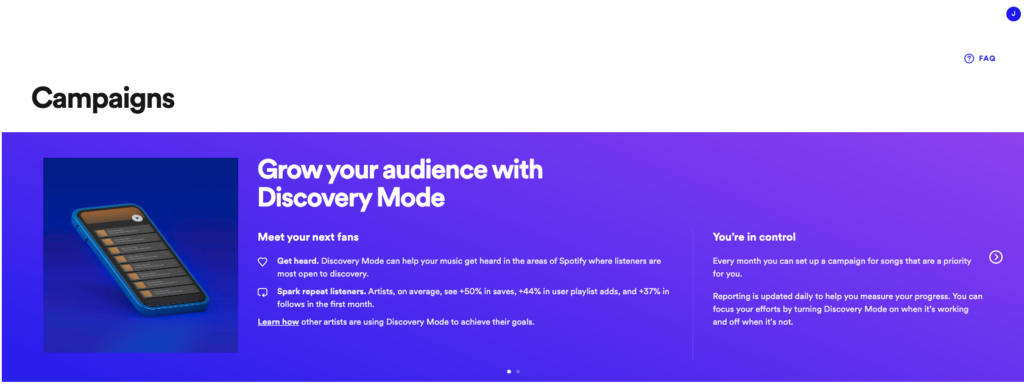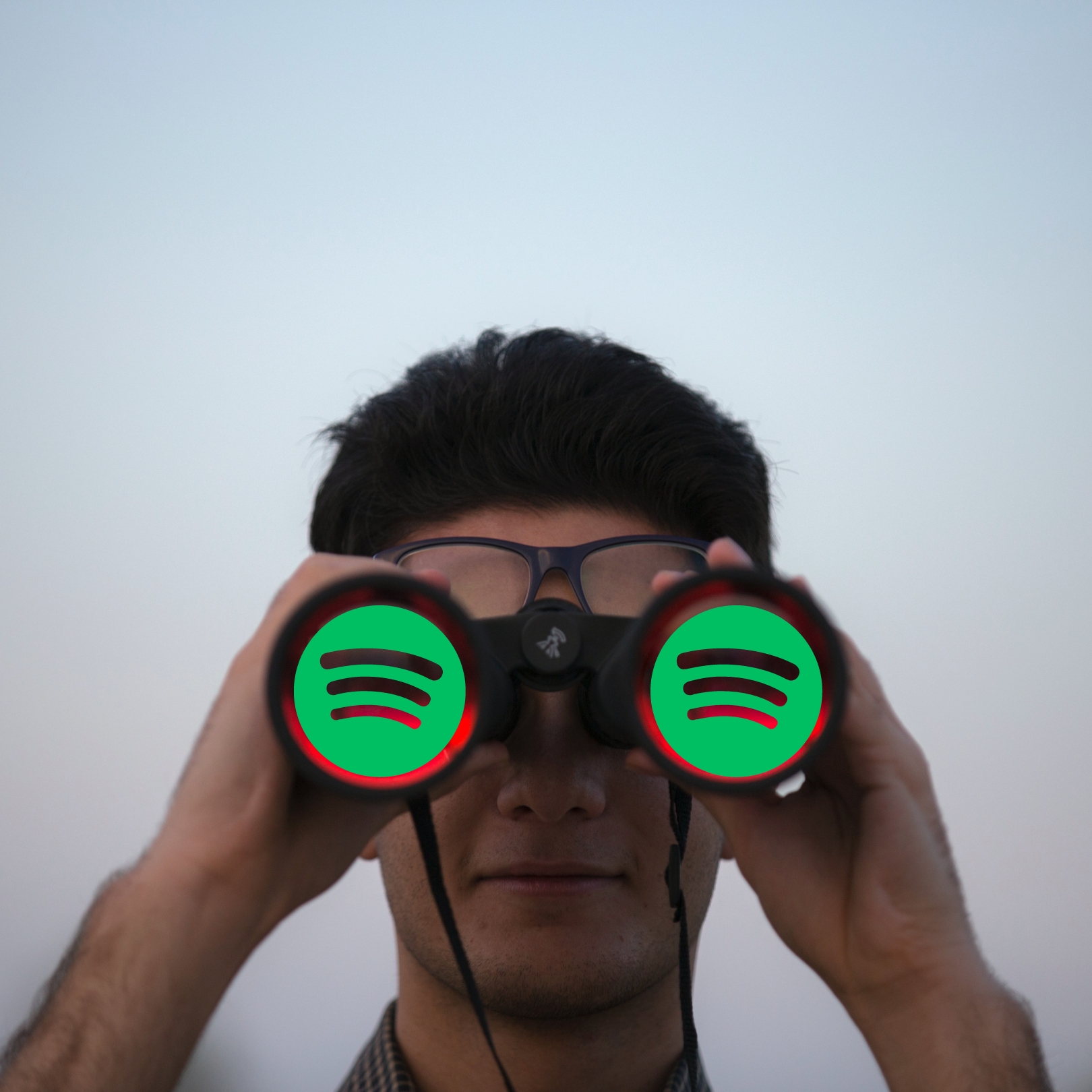There are two ways to look at Spotify Discovery Mode:
- It’s a new tool that can help you reach new fans without spending a fortune, letting Spotify introduce your music to listeners already familiar with your genre…
- Or it’s another way for Spotify to earn some extra cash from the frugal artists trying to make it in the increasingly competitive and expensive music business.
As it often happens, the truth is in the middle.
So, today, I’m going to explain Discovery Mode (including how you can use it to promote your songs) and highlight the pros and cons of this new marketing tool.
Spotify for Artists promotional tools
First off, if you’re releasing your music on Spotify, make sure you have access to your Spotify for Artists. It’s a must for every musician and everyone in your team.
With Spotify for Artists, you get access to a set of tools to help you promote your music in different ways within Spotify.
Spotify for Artist’s main tools include:
- Customize your Artist Page to keep it updated with photos, bio, playlists, releases, merch, and Artist’s Pick. It should tell your fans who you are when they enter your page.
- Add Canvas to our tracks. With these looping visuals in your tracks, you could engage with more fans and invite people to share your songs in their stories, attracting even more people from outside Spotify. According to the streaming platform, you can get up to 9% more visits to your profile with Canvas. They’re easy to create even with limited editing skills, thanks to Canvas creators available online.
- Marquee allows you to run ad campaigns inside Spotify. They’re available in the Spotify app and will appear in a pop-up window to potential fans. They’re great for inviting new listeners to stream your music or letting returning listeners know when you have a new release.
- Spotify for Artists offers analytics reports of your streams, listeners, saves, playlists, and releases. Analyzing this information could help you make future decisions to target ad campaigns to the right audience.
- Discovery Mode is a new addition that encourages artists to choose which songs they want included in Spotify’s algorithmic suggestions and reach a wider audience.
Some other features are pitching to editorial playlists, sharing fundraising links to invite your followers to help you achieve your next project or fundraise for charity, and showcasing your merch for sale and ticket shows directly on your profile.
Pitching to both editorial and listener playlists is an effective way to gain more followers. However, users listen to more music from their personalized playlists: Discover Weekly, Release Radar, Daily Mix, and On Repeat.
Here’s where Discovery Mode changes how Spotify prioritizes your music in the algorithmic playlists. Many artists are starting to use it, in conjunction with Spotify tools like Marquee and Canvas, to create a funnel that will bring more listeners, more streams, and more fans.
Spotify Discovery Mode
Spotify’s Discovery Mode is the solution for those who want to have a say in how their music is recommended to new listeners. According to Spotify, this new tool generates 16 billion artist discoveries monthly on their platform, 33% of which occur thanks to Radio and Autoplay features.
Discovery Mode helps you influence which songs you want the Spotify algorithm to prioritize. Spotify will then suggest those tracks on Radio and Autoplay to listeners who may like them. Autoplay and Radio are two streaming sources where to find listeners already interested in music similar to yours.
With Radio, listeners get a list of songs based on a specific artist, album, or playlist. Radio playlists are updated regularly by the platform’s algorithm.
Autoplay is a Spotify recommendation that plays right after an album, a playlist, or song ends. Autoplay is a feature that can be turned on and off from your Spotify app settings and is on by default.
Discovery Mode has drawn the attention of independent distributors and artists with a low budget for promotion, because without requiring an upfront cost, it promises a more effective way to use the algorithm to place your music in Radio and Autoplay.
Yeah, that’s right; when you select tracks with Discovery Mode, you don’t need to set a budget to run your campaigns until it’s all spent –you can start using Discovery Mode without paying up-front.
However, the songs streamed through Discovery Mode via Radio and Autoplay won’t generate the regular revenues Spotify offers for other types of streams. More on this later.
Discovery Mode does not guarantee that you’ll get more streams or followers; it’ll only recommend your song more often. If users are not engaging with your piece, Spotify will stop recommending it on Radio and Autoplay.
Finally, it’s worth noting that Discovery Mode has been in test mode for a while and is just now expanding to new markets (as of March 2024). With the statistics they have from their initial test, they’ve found that during the first month of using Discovery Mode, artists get 37% more followers, track saves increase by 50%, and songs are added to playlists 44% more often.
How does Discovery Mode work?
Time to get into the nuts and bolts.
If you have songs eligible for Discovery Mode, they’ll be available from your Spotify for Artist page, where you can turn on and off Discovery Mode for every song. Spotify takes many factors into account to suggest music to personalized playlists, Radio and Autoplay, including the genre, time of the day you listen to the song, language, song length, musical elements, and tempo.
Since Discovery Mode has been active, the artist’s opinion has also become a factor that the algorithm considers when choosing songs. While you’ll keep control of how many tracks and for how long you want them on Discovery Mode, Spotify will place them on Radio and Autoplay more frequently.
You may be thinking that’s something Spotify already does, and while that’s true, with this feature, you’re encouraging Spotify to do it more often and to do so in more Radio playlists. So, you should expect more streams via Radio playlists and Autoplay in your analytics.
Spotify will not only be placing your selected tracks into these playlists but will also analyze the user interaction with your songs. If they skip your track, add it to their playlists, save it, or replay it again, it will determine whether or not Spotify continues recommending your music.
For now, it seems artists have been happy with Discovery Mode. Click over to Spotify’s blog and you can see success stories from independent artist mehro, who grew his fanbase thanks to Discover Mode.
Other examples of success with Discovery Mode include Terrace Martin, Natalie Perez, ODIE, and Magic City Hippies. You can read their stories to find creative ways of using Spotify tools to your advantage. And, of course, indie artists who haven’t been interviewed directly by Spotify are using the tool, too.
How do you pay for Spotify Discovery Mode?
There have been controversies about Spotify Discovery Mode due to how it works, especially regarding the cost of the campaign. Because no budget is needed to start running Discovery Mode, Spotify will collect payment through your royalties.
You will collect fewer royalties for every song streamed via Discovery Mode, but there’s potential to grow your streams and followers for your music in exchange.
It’s important to mention that this commission from your royalties will only apply to streams where Discovery Mode is active. If users save your song and follow you and then stream your music from your artist’s page, their library, or their personal playlists, then you will collect your regular share of royalties.
According to some managers, they’ve seen an average reduction of 30% in their royalties from Discovery Mode. If this deduction is compensated by a larger number of streams, then it’s all good, but that doesn’t happen every time, which is why you need to analyze your data and decide whether this tool works for you.
Spotify Discovery Mode eligibility.
To be eligible for Spotify Discovery Mode, you’ll need to meet the following criteria:
- The artist’s profile is registered in one of these countries: Australia, India, Ireland, Jamaica, New Zealand, Nigeria, Norway, the Philippines, Singapore, South Africa, Sweden, Trinidad and Tobago, the United Kingdom, or the United States.
- You have at least 25,000 monthly listeners. Though many artists with access to Discovery Mode say they don’t meet this requirement, Spotify recommends it.
- You must distribute your music via a participant distributor such as DistroKid, CD Baby, Stem, Venice Music, and Vydia.
- Your track must have been released on Spotify for at least 30 days.
- Your song has been played on Radio or autoplay in the last seven days.
Spotify says they are working on getting to more countries and adding more distributors so any artists releasing music on Spotify can enjoy the benefits from Discovery Mode.
How to set up a Discovery Mode campaign.

Log in to Spotify for Artists. Request access to your label or team if you don’t have it.
You will find it under your Campaigns tab if you are eligible for Discovery Mode. Choose Discovery Mode and then click the Set Up Campaign button.
In the next screen, you will see all the eligible tracks for Discovery Mode listed. Select the tracks you want to prioritize and click Next at the bottom.
Review your campaign and click submit to schedule your Discovery Mode campaign.
Your campaign will begin running on the first day of the following month, and you’ll see results after eleven days.
You can edit your campaign until the last day of the current month, before the campaign start, to make any changes.
What can you expect from Discovery Mode?
All in all, Discovery Mode is an innovative form of self-promotion: you decide which of your songs you want listeners to hear first and pay the platform to introduce your track.
You’re basically running campaigns for 30% of your royalties. This will be more affordable for some artists than running campaigns outside Spotify with a limited budget. With Discovery Mode, you only need to pay once your music has been streamed, and the fee will be cut off from your revenues.
Artists are worried that once Discovery Mode becomes available in more markets, the platform will become more competitive, and only those who use this feature will be listed on the algorithmic playlists.
For artists who rely on Spotify streams as a primary source of income, this might impact them negatively because they’ll need to stay relevant in the algorithmic playlists while also competing with all the other artists using Discovery Mode.
While this scenario may seem gloomy, I suggest you look at Discovery Mode as an alternative way to reach new fans by highlighting your best works and presenting your artistry to a new potential audience the way you want to do it.
Final thoughts
Discovery Mode is not for everyone and doesn’t guarantee any results. It can help upcoming artists promote their songs, but I’d recommend using it as part of a more all-encompassing marketing strategy, including social media and playlist pitching. Expecting incredible results from using Discovery Mode alone will result in royalty loss and have you question the quality of your work.
Test it with your latest release and monitor the results. It might be what you were looking for, and even if it’s not, it could still be a valuable tool to include in your music release strategy.








